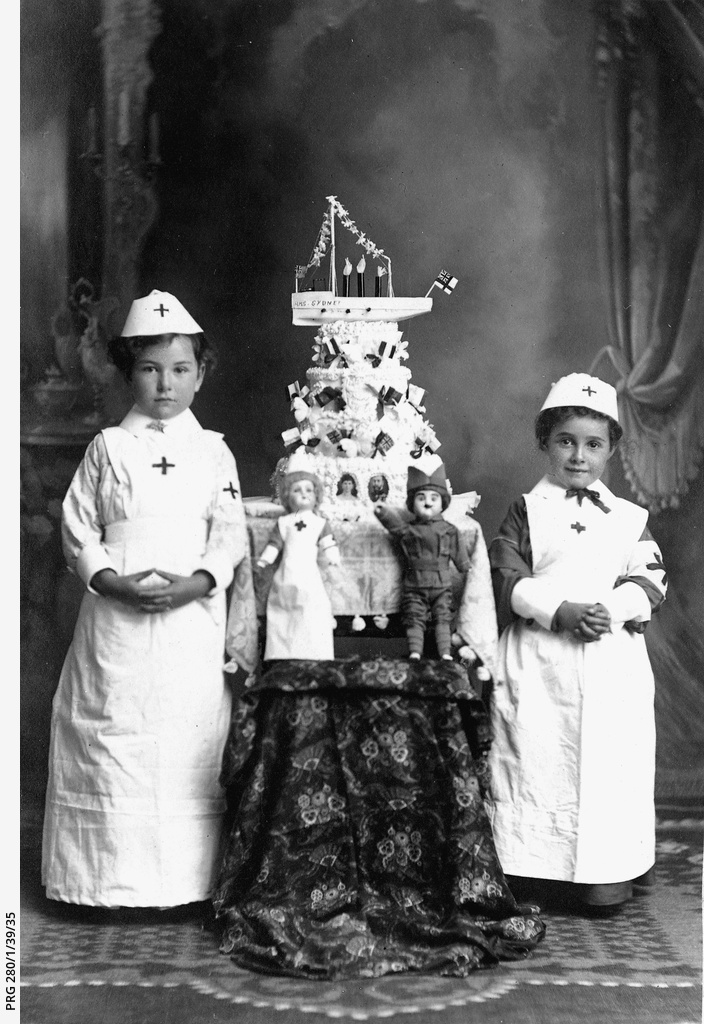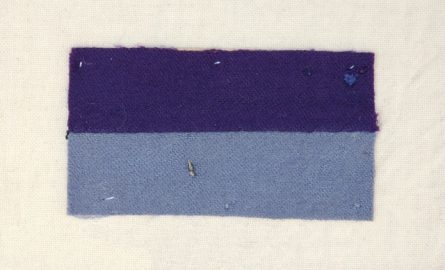

Two children dressed in Red Cross Uniforms, c 1915 Image courtesy State Library of South Australia PRG-280-1-39-35
Glossary Terms
Topics
Italy joins the war, Sinking of the Lusitania, Second Battle of Ypres
People
Terrell, Frederick Leopold, Cooper, Ethel, Lady Galway, Avery, Louis Willyama, Seager, Alexandrine, Smith, Ross
Organisations
3rd Light Horse Regiment, Cheer-Up Society, Advertiser, Red Cross, 10th Battalion
May, 1915
“I heartily congratulate you upon the splendid conduct and bravery displayed by the Australian troops in the operations at the Dardanelles, who, indeed, proved themselves worthy sons of the Empire”
The words of His Majesty, King George V, were music to the ears of Australians, inspiring Alexandrine Seager, founder of the Cheer Up Society to pen another poem (refer below) praising the Australian soldiers and deriding those who had criticised their behaviour.
In May the newspapers in South Australia continued to be filled with news of the war. There were detailed daily updates from Europe and of course information about what was happening in the Dardanelles (very favourable to the Australians, of course). On 3 May, the first casualty lists were printed in the paper – two South Australians were listed as dead and two as wounded. In the following days additional lists were published. The 25th list appeared in the Advertiser on 29 May. It noted that among the casualties were 14 South Australian officers killed, 65 wounded; 34 Privates killed, 374 wounded and 1 missing. Soon the pages of the paper also contained short biographies of some of the dead and portrait photographs with headlines like ‘Australian Heroes’. News also reached South Australia that the Australian commander, Major General William Bridges had died from wounds received in the fighting at Gallipoli.
Alongside battlefront news were stories about the ongoing war efforts at home: there were acknowledgements of donations of socks and balaclavas; fundraising events (such as a Flower Day in Port Adelaide and a ‘khaki concert’ held by the Cheer Up Society). The range of requests to the public was quite extraordinary and unimaginable today: there were calls for towels for hospitals and for people to make mosquito nets to protect wounded soldiers in Egypt. Some even urged that knitting be introduced as a compulsory subject for all girls over 9 years, so they too could contribute to the war effort.
At Gallipoli on 9 May, the Australians launched an offensive on the enemy lines at Quinn’s Post, but the Ottoman counter attack erased any gains. This was followed on 19 May by an Ottoman offensive, during which more than 3000 Turks were killed. There were so many bodies that on 24 May a truce was arranged so the dead could be buried.
From the official diary of the 10th Battalion and from Louis Avery’s personal diary, we learn a little of what life was like for the soldiers during these days: in the first days of May, Avery records that he was hit twice by bullets, but received only superficial wounds. He also mentions several short armistices for both sides to bury their dead. Leo Terrell was still in Australia, but his unit in Victoria was preparing for embarkation – so on leave back in Adelaide, he purchased a ring for Clara, and the engagement was official. We also meet a new correspondent this month – Ross Smith, who landed at Gallipoli with the 3rd Light Horse Regiment 15 days after the initial landing. His reflections on his first experience of war make compelling reading.
There were still plenty of South Australians willing to enlist – indeed, news from Gallipoli prompted a spike in national enlistments. Soldiers in training continued to march through the streets of Adelaide before enthusiastic crowds. Doctors and nurses too, were encouraged to enlist, although there were no positions considered suitable for ‘lady doctors’.
Towards the middle of the month, South Australians learned that some of the wounded were convalescing in England, while others were expected to return to Australia where hospitals, carers and supplies would be required. Reminiscent of Downton Abbey, The Advertiser reported that Mr Robert Barr Smith had offered his home, the 80-roomed mansion in Torrens Park (now park of Scotch College) as a convalescent home, and others made similar offers.
Empire Day (the anniversary of Queen Victoria’s birth) was celebrated with greater fervour than in previous years on 21 May, and 22 May was the start of Manufacturing Week, a showcase for locally produced goods, and an opportunity to spruik the benefits of supporting local industry. Drought-breaking rains were recorded around the country, but still some supplies (butter and meat in particular) were in short supply and rising in price. There were also cases where bakers were convicted of selling short-weight bread (ie loaves that weighed less than they claimed). Adelaide also became the focus of the nation as the Federal Labor Party Conference opened on 31 May, bringing the Prime Minister (Andrew Fisher) and other leaders to the state.
In Germany, South Australian woman Ethel Cooper, still unable to send any of the letters that she has written from Leipzig to her sister in Adelaide, noted with optimism Italy’s declaration of war on Germany and Austria. She also made mention of the ‘scandal’ of the sinking of the Lusitania by German submarines.
As the Anzacs continued fighting in the Dardanelles, in Belgium the War had taken a sinister turn with the first successful widespread use of chlorine gas by the Germans in the Second Battle of Ypres. Not long afterwards, Lord Kitchener, the British Secretary of State for War, announced that the British would follow suit.
This war was far from over.
















